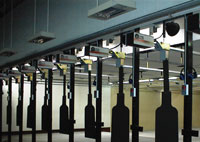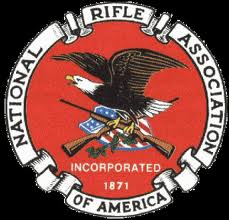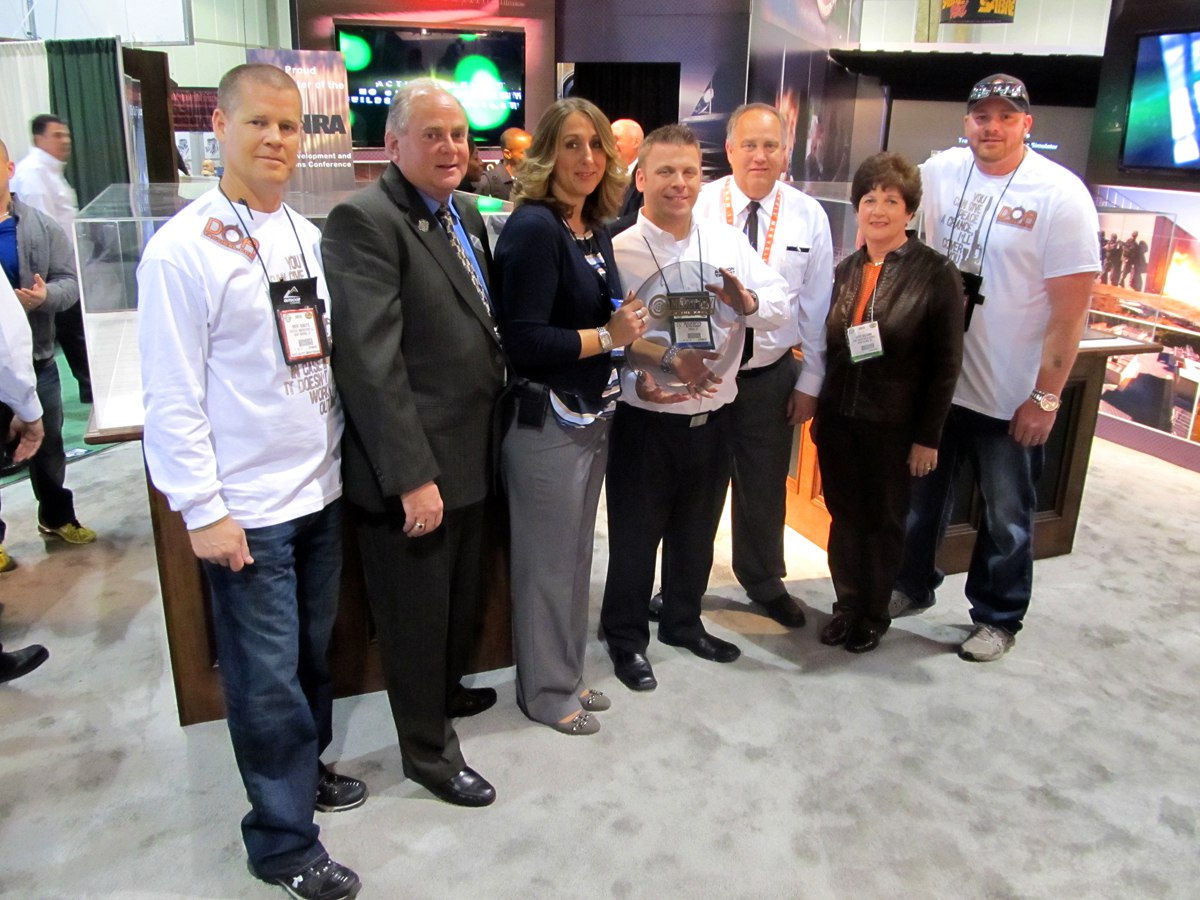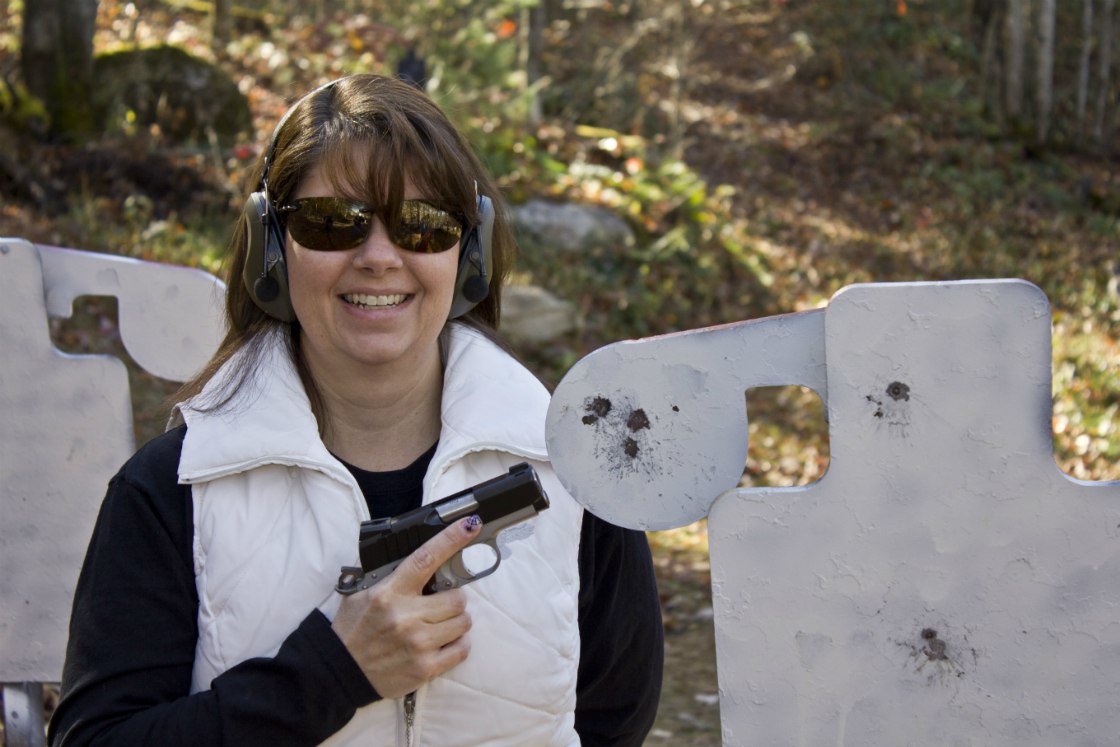BY ABNER MIRANDA
Editor’s Note: Action Target has republished this article in its entirety with the permission of the author. Ideas, comments, practices, recommendations, etc. are the author’s own and do not necessarily represent those of Action Target.
Last year I attended a shortened version of the world famous Rogers Range Course (RRC). It was put on by High Caliber Training in Crittenden County, AR. In law enforcement, pistol craft is your bread and butter and reactive shooting is a must-have for the modern officer. Reactive shooting is the condition in which you cease to think about engaging the target and just do it. The course of fire at the RRC is comprised of seven, pneumatically operated targets across five shooting stands that are staggered from seven to 20 yards. The shooter stands inside a framed doorway inset in a wall that runs the length of the multi-bay RRC. From this position, you fire nine challenging courses of fire, during which 8″ steel targets are only exposed from .5 to .75 seconds each. Those times are tough considering that a precision shooter’s reaction time to hit a target, from a security holster, is about 1.5 seconds. Upon leaving the course with a final score of around 70%, if memory serves, I was stunned that “a top notch shooter who is accustomed to scoring no less than in the high 90’s would score so poorly.” OK, all drama set aside, the fact is that at the RRC a 70% is pretty darn good considering just how hard this kind of training is. I spoke with Bill Rogers at SHOT Show 2012 and he told me that it was a respectable score. So there you go. Now I feel better.
Upon returning home from the RRC I knew that I had to incorporate those things that I’d learned into my weekly training time on my home range. It was then that I reached out to Action Target and requested to borrow some of their steel targets. I have, since then, cast off all of my paper targets, except for zeroing purposes and have gone to all steel. Why you may ask? Once you transition to steel you will NEVER go back to shooting paper…ever! Nothing is better at giving the shooter instant feedback than hitting a reactive steel target.
Practice Makes Permanent
After a solid year of looking for a piece of property that would allow me to shoot unfettered, I found a 3.5 acre piece of land in southeastern Tennessee that fit the bill. Since moving in I have set out to create a range that allows me to do all of the things that I could never get away with at my LE range. Cars, house doors, cinder blocks, watermelons, body armor, and armored glass—you name it, we shoot it. With multiple barriers and about 17 reactive steel targets, I have the range that I’ve always wanted. By incorporating the training that Bill Rogers has laid out in his courses, I have started honing my shooting skills and am now passing these skills onto my friends and family.
There is a saying in shooting that goes “perfect practice makes perfect.” Most of us are accustomed to hearing “practice makes perfect.” However, time has shown us that practice only makes permanent. In other words, repetition makes something permanent—it doesn’t make it right. When you were a kid learning to play baseball, how many times did you hear your coach yell “keep your eye on the ball!”? Through devotion and arduous repetition, the moment finally arrives when the young athlete hears the crack of the bat and sends the ball sailing over the outfield. Within 300 milliseconds of the success, the mind forms a positive neural pathway and stores the muscle memory labeling it “success!” Bill refers to this similar phenomenon in shooting as Positive Instant Recognition (PIR). PIR in shooting, just as in sports, must be recognized immediately or else the mind won’t record the success as such. This is easy in sports because you can see, feel, and hear the contact with the ball. In shooting, PIR is almost impossible to achieve because a fired shot that misses a paper target sounds and feels exactly like one that pierces the 10 ring. So how does one achieve PIR in shooting? Ditch the paper targets and go to all steel. With the instant feedback of ringing steel, the shooter gets the PIR that’s desperately needed to form a positive neural pathway.
![Dueling Tree (front) [web]](https://www.actiontarget.com/wp-content/uploads/2012/04/Dueling-Tree-front-web-300x300.jpg)
the most versatile. Not only does it offer an exhilarating speed challenge while shooting up close, it also offers a positive swinging action that can be easily seen from far away. Available in AR550 through-hardened steel capable of absorbing rifle fire, the Dueling Tree offers years of training in an affordable target. Refacing these five-foot tall targets is as easy as spray-painting the bullet hits away.
To read the rest of the article and to hear more about Abner Miranda’s innovative use of Action Target’s Dueling Tree Targets, please refer to next week’s Action Target Journal article.
About the Author
Abner Miranda is a patrol officer at Signal Mountain (TN) Police Department. He is an FBI-trained hostage negotiator, a tactical rifle instructor, and an AR-15 armorer.







 First off, it must be remembered that the range exists as the profit center to the business. Secondly, a decision needs to be made in regards to the operations of the range. In regard to the commercial value of a range, there are typically two lines of thought in the industry: one is to combine the range with the store, and the second is to not.
First off, it must be remembered that the range exists as the profit center to the business. Secondly, a decision needs to be made in regards to the operations of the range. In regard to the commercial value of a range, there are typically two lines of thought in the industry: one is to combine the range with the store, and the second is to not. The specific purpose of the Portable Target Course Book is to “ensure trainees a program that is designed to develop trainings that are safe, test fundamental skills, increase and enhance movement, improve the target selection thought processes, and enhance overall tactical awareness.” Action Target’s Portable Targets have become an industry standard and leader and the course book allows for a better overall training experience.
The specific purpose of the Portable Target Course Book is to “ensure trainees a program that is designed to develop trainings that are safe, test fundamental skills, increase and enhance movement, improve the target selection thought processes, and enhance overall tactical awareness.” Action Target’s Portable Targets have become an industry standard and leader and the course book allows for a better overall training experience. Action Target developed the
Action Target developed the 




